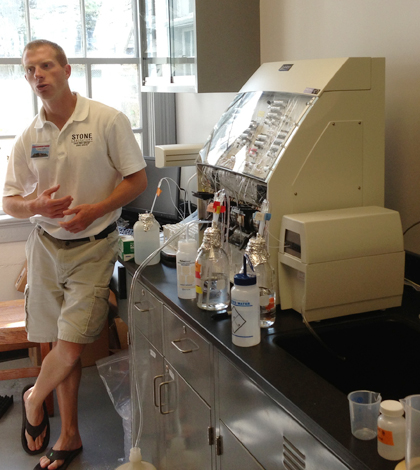Q&A with Justin Chaffin: Taking samples and advising students on Lake Erie

Top image: Justin Chaffin explains instrumentation and algae analysis at the new Ohio Sea Grant water quality lab. (Credit: Daniel Kelly)
Justin Chaffin has been working as the research coordinator of the Ohio State University’s Stone Laboratory for about a year. He was appointed to the job while still a doctoral candidate at the University of Toledo where he studied algae and Lake Erie.
Since being appointed to the position, Chaffin hasn’t just been sitting behind a desk giving orders. He’s frequently out on the water taking samples, managing the lab’s lake monitoring technology and working with students.
He also has been a key player in coordinating water quality monitoring practices between state regulators, researchers and charter boat captains in an effort understand and compare data collection practices occurring across the Lake Erie’s Western Basin.
Chaffin answered a few questions on his background, current work and efforts to coordinate monitoring during a media event at Stone Lab in historic Stone Cottage on Lake Erie’s Gibraltar Island.
Environmental Monitor: How did you land the job of research coordinator for Stone Lab?
Justin Chaffin: Well, the job description was pretty much to a tee of what my graduate research was. They asked for someone that studied harmful algal blooms and knew about nutrient dynamics, knew about cyanobacteria dynamics, knew about toxin production. I did all that for my Ph.D. research and I did it all in Lake Erie. So, I was a pretty good candidate and I knew about Stone Laboratory to begin with.
EM: We’ve heard a lot about the need for an increased amount of monitoring around Lake Erie. Why do you think that is?
JC: Well, we need to judge whether or not changes in land use are having an impact on the lake. We can use a satellite to see where a bloom is, but we can’t use a satellite to determine if it’s toxic or not. We can’t use a satellite to determine nutrient concentrations. So, if you don’t have your boots on the ground and boats on the water getting a water sample, there are a lot of unknowns regarding that.
The satellite is great to tell you when a bloom occurring and where it’s at. We use the satellite to give a prediction of where that bloom will be in a couple days, but if you don’t have a water sample you are missing a lot of the: “Why is that there?” It’s just: “That’s where the bloom is.”
EM: You have been working to examine data collection methods of different government entities and charter boat captains in Lake Erie, how is that process going?
JC: I think that the steps we made this winter just learning who’s out there, what, when and how they are sampling was a great first step. Then the next step is to see if the data is comparable. If it is, it is. If it’s not, it’s not. Then we need to try to standardize and coordinate methods better. But, without this initial analysis–understanding if this data comparable–you can’t necessarily take the next step.
EM: You work with a lot of students on a regular basis. How do they affect or help you with your research?
JC: At Toledo I had one honors student that worked closely with me, and here at Stone Lab I had two research students this summer. It’s always good to get a different perspective on how the data’s analyzed, especially coming from a more raw form. They might not be able to connect all the dots that I as an advisor might think are obvious. So, when they hand me the first draft of a paper, it’s like, “Ok, here’s something I didn’t explain well enough,” or “I’m not conveying this message well enough,” so I can go back and reassess myself through them.
Top image: Justin Chaffin explains instrumentation and algae analysis at the new Ohio Sea Grant water quality lab. (Credit: Daniel Kelly)




0 comments